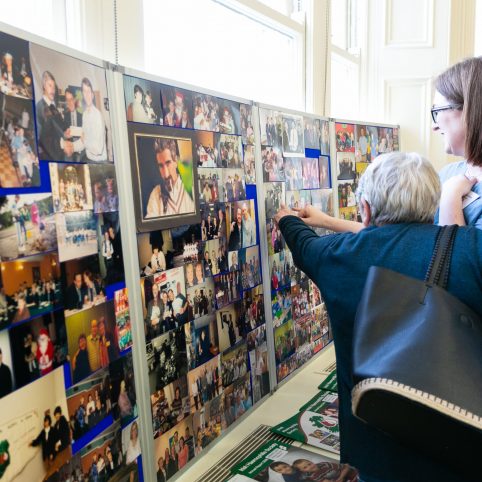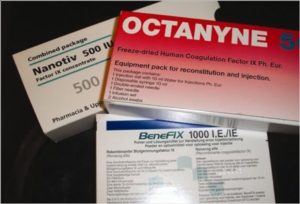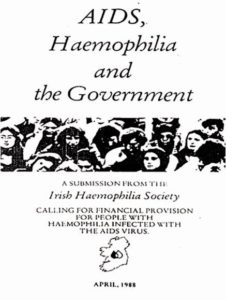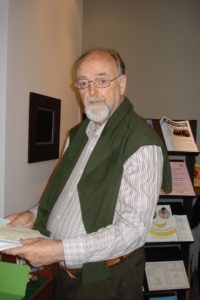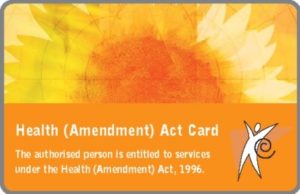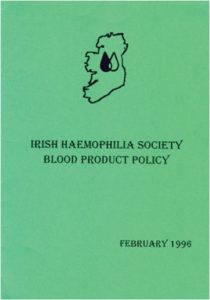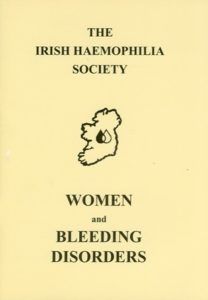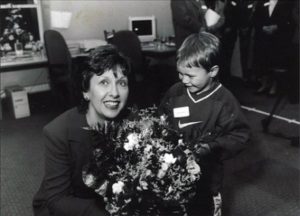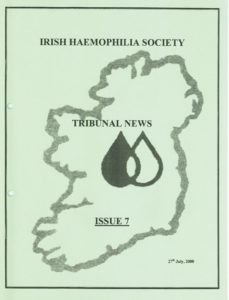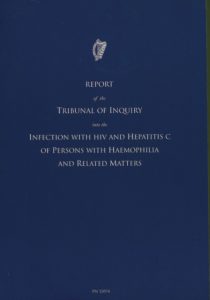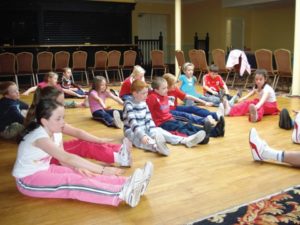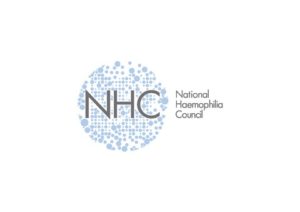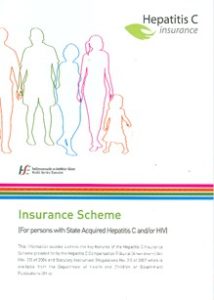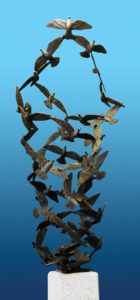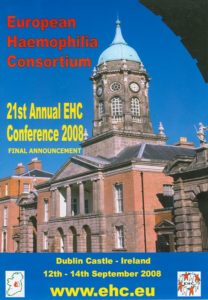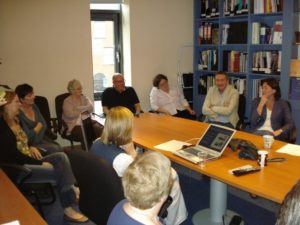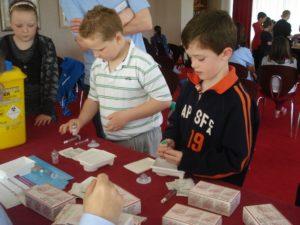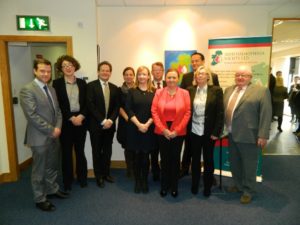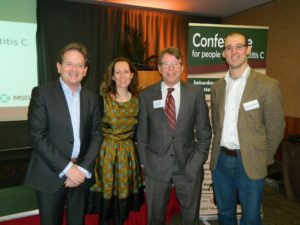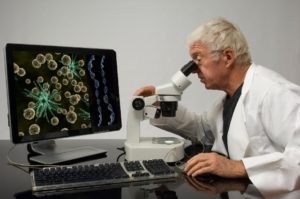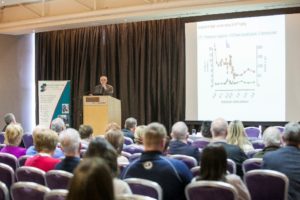To all our members who have journeyed with us over the past forty-nine years and to those who joined the journey along the way. We acknowledge and thank you for your support and friendship, without which we could not have achieved all that has been achieved. The value of the programmes we organise is reflected in the attendance of so many of you at Society events and we will continue to rely on your feedback and support as we endeavour to respond to the changing needs of all our members. As we celebrate fifty years of the I.H.S. in 2018, we remember all those who have died. We realise our strength is in our unity, and we look forward with realistic hope to a bright future.
Below you will find a historical timeline of the first forty-five years…
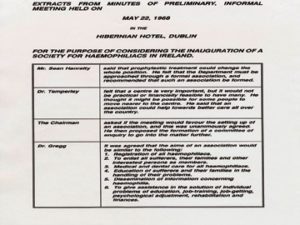
Extracts from the first I.H.S. Meeting
The Irish Haemophilia Society was founded in 1968 by members of the medical profession, people with haemophilia and their families and friends who felt the need to provide support and advice for members and to improve the quality of life for people with haemophilia.
1969
A meeting of the World Federation of Haemophilia was held in Dublin, at which Society members were addressed by international experts for the first time. The Society produced its first newsletter in August 1969. The Government announced that it was setting up a National Haemophilia Centre at the Meath Hospital for adults and at the National Childrens’ Hospital, Harcourt Street for children the following year.
1970
Ninety patients were registered with the National Haemophilia Centre, sixty-five with haemophilia A, twenty-one with haemophilia B and four with von Willebrand’s Disease. Throughout the 1970’s haemophilia progressed from being a severely debilitating disease to a manageable one. The quality of life for people with haemophilia improved, along with the knowledge and expertise of the organisation. The Society offered support to members who were hospitalised in the Meath and Harcourt Street hospitals. Support included visits, provision of games and access to television because in this pre-home treatment era, many people spent significant amounts of time as inpatients.
1975 to 1982
In 1977 a new centre opened in St. James’s Hospital. Home treatment was on the increase, a normal quality of life seemed attainable and the Society offered support to members with home visits, newsletters and other services. At this stage, the committee met at the headquarters of the Irish Cancer Society on a regular basis. By 1982, life expectancy had increased to sixty and life was becoming normal for many members of the Society.
1980’s
The period from 1983 was a very active, traumatic and emotionally difficult time for the Society with the realisation that the blood products which had at last promised a normal quality of life had resulted in the infection of 106 members of the Society with HIV. It was a devastating blow for the entire haemophilia community. As a direct result of infection with HIV and Hepatitis C, some 91 people with haemophilia have died, and the lives of many individuals and families have been decimated. The Society had to face into this immense challenge as a small organisation with a number of dedicated volunteers but no staff, no resources and no office.
1983
The Society produced a report on the need for a new National Treatment Centre. The Society also funded research into the immune system of people with haemophilia in an early response to the spectre of Aids.
1985
Margaret King
Following reports that the Aids virus could be transmitted sexually, the Society took the initiative and began to distribute condoms directly to members. This resulted in the very low rate of transmission of HIV to spouses and partners in Ireland when compared to the haemophilia population in other countries.
1987
The Society undertook a comprehensive survey of the needs of all of the members who had been infected with HIV.
1988
I.H.S. Publication \’Aids, Haemophilia and the Government\’
Based on the results of the survey, the Society drafted a booklet called “Aids, Haemophilia, and the Government”, which called for a concerted response from the Department of Health and State Agencies.
1989
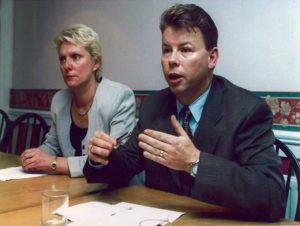
Rosemary Daly & Brian O’Mahony
When this was not forthcoming, the Society organised a political/media campaign for recompense for people with haemophilia infected with HIV. The campaign led to a parliamentary defeat for the government and a General Election in 1989. This culminated in the setting up of the Haemophilia HIV Trust (HHT). The HHT has performed invaluable service to those with HIV and offers ongoing financial assistance for services for people with haemophilia and HIV and their families. Two members of the I.H.S. continue to represent the Society on the HHT.
1990
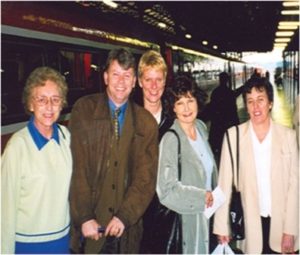
I.H.S. staff during the 1990\’s
The Society offered assistance to members who were suffering from the clinical consequences of HIV and AIDS and provided a critical illness service, home support and nursing service for members. This service continued throughout the decade.
Fr. Paddy McGrath
Support and assistance was also provided to members who were pursuing legal action in relation to their infection with HIV. At the AGM of the Society, we commissioned a lecture on Hepatitis C, an ominous new threat to the community.
Irish Press Article, 19th December 1990
“Haemophiliacs’ who have been infected by the AIDS virus through blood transfusion are victims on the double and their plight should command the most serious attention of the Government. Yesterday it was revealed that since the famous Dáil motion on their behalf in June of last year fifteen such haemophiliacs’ have died and another fifteen to twenty will have died by the time legal actions on their behalf have begun at the end of next year. This is not a situation which either the Government or general public can contemplate with anything but the gravest disquiet. It is profoundly sad that these haemophiliacs’, through no fault of their own, should have to face the long slow agony of death by AIDS. But it is nothing short of disgraceful that they should go to their graves plagued also by the gnawing worry that their families might not be secure. In many cases, these unfortunate victims or their wives have had to give up their jobs because of the constant care which this condition demands. The British Government, not exactly celebrated for its caring attitude, recently recognised its moral duty towards haemophiliacs’ in this dreadful situation. It is time for our Government to do likewise”.
Four candidates who stood in the local elections
Concerned by the mounting death toll from HIV and tortuously slow progression of the legal action, the Society again was compelled to mount a media and political campaign to negotiate a HIV compensation settlement with a reluctant government. Four members of the Society stood in local elections. Following several months of campaigning, a political settlement was reached. This resulted in payments ranging from IR£77,000 to IR£101,000 to each individual with HIV. A payment of IR£20,000 was paid to the families of those who had died as a result of their HIV infection.
1992
The Society turned its attention to seeking improvements in the provision of comprehensive haemophilia care and monitoring developments with blood products. The Society drew up a Blood Product Policy which was communicated to the Department of Health and the National Haemophilia Treatment Centre. The policy set out the Society’s objectives for haemophilia replacement therapy for the next five years. All of the objectives set out in the Blood Product Policy were achieved. The Policy was updated in 1996.
1992
European Haemophilia Consortium
A meeting of the European Haemophilia Consortium was organised by the Society in Dublin. The Society engaged in a Twinning Programme with Hungary. The death toll from HIV continued to increase and the Society continued to offer a high level of service to those affected and their families. Infection of members with Hepatitis C through contaminated blood products emerges as an issue of increasing concern.
1992
The Society moved to a new Headquarters in Eustace Street.
1993
The Society celebrated its 25th anniversary. The AGM was attended by President Mary Robinson.
1994
The Society initiated discussions with the Department of Health in relation to provision of treatment for members who had been infected with Hepatitis C.
1995
The Society negotiated a Compensation Scheme with the Irish Government for people with haemophilia infected with Hepatitis C and agreed that members would attend the newly established Hepatitis C Compensation Tribunal.
1996
The Health Amendment Act is passed with the provision of additional health benefits for members with Hepatitis C.
1996
World Federation Congress, Dublin 1996
The International Congress of the World Federation of Hemophilia was held in Dublin. Some two thousand, four hundred delegates from seventy countries attended, which was a record number. The Society’s Patron, the then President of Ireland Mary Robinson, attended the Congress and addressed the delegates. The Congress was a major success scientifically, socially and in terms of attendance as well as being a major financial success.
1996
Blood Product Policy
The Society worked on a new Blood Product Policy, setting out goals for 2000 and on a new policy on recombinant products for all, with aspirations for prophylaxis set out.
1997
We held seminars for Women with Bleeding Disorders in Dublin and Cork which were attended by a large number of women, many of whom were attending such meetings for the first time. This broadened membership of the Society. The numbers of women joining the Society continued to increase. Following meetings with the Minister for Health, recombinant products were provided for all persons with haemophilia A.
1997
The Society withdrew from the Finlay Tribunal of Inquiry into the Blood Transfusion Service as the tribunal was not dealing in any substantive way with the issues relating to the infection of people with haemophilia.
1997 to 1999
The Society was involved in negotiations with the Department of Health and the Attorney General regarding the terms of reference for a new Tribunal of Inquiry into the infection of people with haemophilia with HIV and Hepatitis C.
1998
President McAleese opening our office in Smithfield
To mark the 30th anniversary of the Society, a publication was produced covering the history of the first 30 years of the Irish Haemophilia Society. The Society moved to a new Headquarters in Smithfield.
1999 to 2001
Tribunal News
Following protracted negotiations and many delays, the Terms of Reference for a Tribunal of Inquiry, into the circumstances of infection of people with haemophilia with HIV and hepatitis C was finally agreed and the Lindsay Tribunal began hearings on 2nd May 2000. Because of the great importance and significance of the Tribunal to our members, and due to the fact that many members would not be in a position to attend the hearings, it was decided to produce the ‘Tribunal News’ which would synopsis in layman’s language the daily proceedings at the Tribunal. The Tribunal News was distributed to the membership of the Society on a weekly basis throughout the hearings of the Lindsay Tribunal of Inquiry. Following one hundred and ninety-six days of evidence, the Society presented its final submissions and recommendations for the future on days 189-191 of the Lindsay Tribunal.
2001
The Product Selection Group (now the Haemophilia Product Selection and Monitoring and Advisory Board) was established. The Society presence on this board gives the organisation a formal role in the selection of factor replacement therapy for people with haemophilia, von Willebrands and related bleeding disorders for the first time. The formal involvement of the Society and key clinicians means that safety, efficacy and quality are, and will continue to be, foremost in the list of selection criteria. To date, the board has completed eight National Tenders resulting in the purchase of some two hundred million units of factor concentrate.
2002
The Lyndsay Tribunal
In September 2002 the report of the Lindsay Tribunal was published. During the Dáil Debate which followed the publication of the report, the Minister for Health made a commitment that people with haemophilia in Ireland will always have access to the safest and most efficacious products available. In line with the recommendations in the report, the Minister for Health agreed that a National Haemophilia Council (NHC) should be set up as a statutory body to advise the Minister, the Department of Health, (and later the HSE) and hospitals on all aspects of haemophilia treatment and care.
2003
Although HIV treatment was much better and had improved since 1996, the clinical impact of Hepatitis C was an increasing problem.
Participation by young people and children at AGM’s and conferences increased to the point where the Society initiated a new format for our conferences. We introduced four strands to each of our major conferences, the main programme of lectures, a programme for teenagers, young adults, a children’s programme and crèche facilities.
2004
The National Haemophilia Council became a Statutory Body with formal involvement for the I.H.S. in recommending policy and priorities on haemophilia.
2004
The National Haemophilia Council managed a vCJD risk assessment based on the risk to members who had used plasma-derived concentrates from the UK in the past. This was the first major example of proactive collaboration between the Society, the clinicians and the Department of Health.
2006
The Insurance Scheme
The Hepatitis C & HIV Insurance Scheme was signed into law. A members conference was organised in October and was successful to the extent of becoming an annual event.
2006
The Society set out a new Strategic Plan designed to ensure that optimum levels of support and services were provided to all members, that the Society is effectively represented on all external bodies and agencies and ensuring the long-term viability of the Society.
2007
The Insurance Scheme started. The Society worked with individual members to optimise their participation, and availability of the Scheme. By the end of the first year of the Scheme, forty percent of eligible members had availed of Life Insurance which was a multiple of the take up from other eligible organisations.
President Mary McAleese opening our new headquarters
Finally, our own new headquarters. The Society moved to a brand new headquarters in New Street in Dublin 8. The new headquarters was officially opened on 14th June 2007 by President Mary McAleese. A DVD was produced by the Society and features several members of the Society who explained the development of haemophilia care in Ireland over the past forty years by telling their personal stories.
Memorial Sculpture
The Society celebrated forty years. To mark this occasion a service was held in our headquarters to mark the unveiling of a sculpture which represents a time of tragic loss, achievement and hope for the future.
21st EHC Conference 2008
We proudly hosted the European Haemophilia Consortium Conference in Dublin Castle which was attended by delegates from 35 European countries.
2009
2009 was a year of firsts with the introduction of third-weekend conference aimed specifically for parents and the organisation of meetings for relatives.
The first ever Parents Weekend took place in the Marriott Ashbourne Hotel in April and attendance at the conference was very high. Topics at the weekend included prophylaxis, sibling issues, needle phobia and sport. A Relatives Day took place in September for the extended family – aunts, uncles, cousins, grandparents etc. This meeting was addressed by Dr. Clodagh Ryan and again proved very successful. Indeed, attendances at all our meetings and events were increased in 2009. A highlight at this year’s AGM was a talk by Dr. Mamman Chandy from India who talked about haemophilia care in India. Dr. Chandy also took time at the weekend to talk about this subject with the Kidlink and Youth groups. At the Saturday night dinner, the Kidlink and Youth Group showcased their acting abilities in their movie High School Musical and Margaret Dunne was presented with a Life Membership for the Irish Haemophilia Society as she retires from her role as Administrator in the society. Debbie Greene was appointed Administrator of the I.H.S. in the Summer of 2009.
2010
2010 was a challenging year for the Society, but despite the recession and tighter budgets, we retained the same level of services and support for our members. At the AGM in March, attendances were high and a new board member was appointed.
After the success of the Parents Weekend in 2009, the conference was repeated in 2010 and attendances increased from the previous year. The conference covered a number of issues including communication, parenting skills and saw the setting up of both a Mothers and Fathers Workshops. Although the Kidlink and Youth programme was jam packed with activities, the highlight of the weekend was without a doubt the self-infusion workshop which took place on Sunday morning. The feedback in general from the weekend was very positive. In January 2010, the Society organised a conference to bring consensus in relation to the collection of blood and plasma globally. The two-day meeting resulted in an agreement called the Dublin Consensus Statement. In July, several staff, board members and members of the I.H.S. attended the WFH World Congress in Buenos Aires. As well as having a large contingent attend the conference, the Society was well published with nine posters on display in the exhibition area. 2010 was a year in which the I.H.S. excelled in publications, with six booklets produced throughout the year as well as the quarterly newsletter and the Annual Report. We also launched into the world of social media with the creation of a discussion forum and an I.H.S. Facebook page. In November 2010, the board and staff of the I.H.S. gathered together to review the strategic plan. Over the weekend, a new strategic plan was created which ran from 2011 to 2014. The new plan would form the basis of our work for the coming four years.
2011
2011 brought a New Year and with it, new opportunities and challenges for the Society. Opportunities such as the development and implementation of a new conference for young men with haemophilia aged 18 to 30 years, and the long awaited opening of the new treatment centre in Cork which took place in July.
Challenges in the familiar guises relating to funding, the continuation of treatment and maintaining existing services continued. We continued to develop our strategic plan, which is an excellent way for us to focus on selected goals, measure our progress, and build on our success. 2011 saw a very big increase in the attendance at our conferences, which also meant there was a greater need for volunteers, therefore a targeted volunteer drive took place in late 2011. The website was refreshed and revamped in November 2011. The Society started a twinning programme with Vietnam, a country just starting out on a journey to better care, with a community that is active and productive, with committed doctors and enthusiastic young patient leaders. In April 2011, the I.H.S. community was saddened by the death of our dear friend Father Paddy McGrath. Members of the Society would have known Paddy who was a great support to members, particularly in the 80’s. 2011 also saw a refreshed appearance for our publications. The Society staff were personally in contact with 89.2% of members by phone during 2011. A number of members were also visited in their homes and regional visits took place in Cork, Kerry, Donegal and Galway. Our work continued on the statutory bodies the National Haemophilia Council and the Haemophilia Product Selection Board. The process of our involvement resulted in significant savings for the exchequer with no decrease in the quantity or quality of replacement therapy. It was a very busy year, but a very interesting year and it is great to see a proactive board and staff who work very well together to provide optimum support and services for all people with haemophilia and related bleeding disorders.
2012
2012 was a very interesting and encouraging year. Longer acting factor concentrates were in the latter stages of clinical trials. A lot of progress was made in relation to gene therapy. The future looked promising. The role out of the latest generation of Hepatitis treatments took place in 2012, and although the course of treatment was long and arduous, these treatments held the promise of greater efficacy, decreased toxicity and an increase response and cure rate. In 2012 the site for the new Children’s Hospital was announced as St. James’s Hospital, which would mean a more integrated service approach for haemophilia. The Society purchased a new accommodation facility for members, near St. James’s Hospital, with the help of a 5 Year Planned Giving Appeal. The Society hosted its first long-awaited PEP (Parents Empowering Parents) Conference which was a great success and very beneficial to parents who attended. The Society organised an AGM & Conference, a Parents\’ Conference, a Members’ Conference, a conference for young men, a conference for those affected by Hepatitis C and/or HIV, regional and home visits and various other information meetings.
The twinning partnership continued to develop in 2012 with various workshops and training both in Vietnam and Ireland. The Society produced many publications including four quarterly magazines, an annual report, two \’Positive News\’ supplements publications entitled ‘von Willebrand’s Disease’, ‘Haemophilia Heroes’, ‘Sibling Superstars’, ‘Portacaths’, and ‘Mild Haemophilia’. Work commenced on the new In-Patient Unit in St. James’s hospital which opened in October 2013. The Society continued to grow and offered a wide variety of services and support to people including counselling, home and hospital visits, and continue to work tirelessly on behalf of all members of the Irish Haemophilia Society.
2013
The year 2013 was an exceptionally busy and productive year for the Irish Haemophilia Society. Our policy of continuous education of members on all aspects of haemophilia and bleeding disorders continued with a record number of conferences. A total of seven conferences for members were held throughout the year. The numbers attending the conferences were exceptional. The accumulative attendance of the three largest conferences was 585 people, a 21% increase since 2011.
A lot of individual and specific support was delivered to members who were undergoing treatment for Hepatitis C and from this, also grew a network of peer to peer support among those on treatment. Assistance with accommodation when visiting the hospital and also with coping with the additional financial burden of regular attendance for treatment was provided to members.
The Society’s involvement in statutory bodies continued and expanded in 2013. We continued to work as part of the National Haemophilia Council (NHC) to progress issues such as the provision of the National Treatment Guidelines and the opening of the new haemophilia H&H In-Patient unit in St. James’s Hospital. The Haemophilia Product Selection and Monitoring Advisory Board (HPSMAB) carried out a procurement process during the year for Factor X deficiency. The Society were very aware that there is a new generation of haemophilia therapies currently under development. These longer lasting factor concentrates now had the potential to transform haemophilia care for many people with haemophilia in the future. The Society were also formally represented on the NCHCD Patient Panel and on the vCJD Incident Panel and on the board of the Irish Blood Transfusion Service.
Our contribution to the development of haemophilia care worldwide continued. Our twinning programme with Vietnam had a very successful year. Additional training was carried out for volunteers and chapter leaders in Vietnam and agreement was reached on the parameters for a micro-employment project, a home adaptation project and the provision of English classes for people with haemophilia in Vietnam.
2014
A major priority for the Society during 2014 year was Hepatitis C treatment. We also fostered what was an extraordinary degree of peer to peer support and interaction between those on treatment. The results of all of this work from the Society and the dedication and commitment of our members who were on treatment was obvious from the results. The overall success rate for those treatments for people treated in Ireland was 51% but the overall success rate in people with haemophilia was 80%. The difference was due almost entirely to the fact that people with haemophilia complied strictly with the treatment regime but also – through the help and support of their families, peers and the Society and their resilience, no person with haemophilia stopped the treatment due to their inability to tolerate the side effects. For those of our members with very severe liver disease or for those of whom the previous treatment has failed, 2014 brought encouraging news with regard to the development of a new generation of direct acting anti-viral therapies for Hepatitis C. We advocated continuously in 2014 for the availability of these new direct acting anti-viral therapies.
The Society also advocated publicly during 2014 for the building of the Children’s Hospital at the St. James’s site. It remained our firm view that having the National Children’s Hospital on the St. James’s campus was by far the best option given the broad range of specialities available in St. James’s.
In April, we commemorated the fact that it was 25 years since the Dáil vote in 1989 on haemophilia and HIV which led to the 1989 general election. It was commemorated with a visit to the office by the Minister for Public Expenditure and Reform, Mr. Brendan Howlin who was the T.D in 1989 who proposed the motion in the Dáil.
In 2014, we also completed a new strategic plan which would start in 2015. Strategic planning is vital for the future success of the organisation as it identifies a clear direction and goals. With regard to the strategic plan completed at the end of 2014, 88% of the strategies were achieved. The new plan consists of four broad goals, 41 objectives and 194 strategies which we will work to achieve before the end of 2018.
Our publications for the year included our regular magazines and annual report; furthermore we published two editions of ‘Positive News’ (our Hepatitis C magazine). We also produced a specific booklet on ‘Vein Care’ and a publication for ‘Teenage Girls with Bleeding Disorders’. In terms of social media presence, our Facebook page was supplemented by joining Twitter, Google+ and LinkedIn.
2015
Hepatitis C continued to be a major priority in 2015. The availability of the new direct-acting antiviral therapies for Hepatitis C resulted in a sustained virological response or cure rate of approximately 95% and which transformed the therapeutic landscape for Hepatitis C. We actively advocated during the course of the year for prioritised access to these new therapies for people with haemophilia and for other state infected patients who were infected with blood and blood products. The health protection surveillance centre database report on Hepatitis C clearly demonstrated a more rapid clinical progression of liver disease in people with haemophilia and blood transfusion recipients. Our advocacy work in these areas resulted in a firm commitment from the Minister for Health that all state infected patients would be offered treatment by the end of 2017 at the latest and ideally by the end of 2016. We also worked with the National Centre for Hereditary Coagulation Disorders and Hepatology centres to ensure that people with haemophilia were offered treatment in 2015. We engaged directly with our members with Hepatitis C on an individual basis to ensure that they were aware of the benefits of these new treatments and assisted them in accessing treatment. In addition to our conference for members with HIV and Hepatitis C, we organised two additional conferences in this area in 2015. We organised an open Hepatitis C conference in early 2015.
The Society organised a record number of conferences in 2015 for the organisation which resulted in a record attendance. A total of eight conferences were organised which were attended by 965 people in total. That was a 42% increase in attendance at conferences when compared to 2014. In 2015, additional conferences were held on ageing and haemophilia, an open conference on Hepatitis C and a conference on Hepatitis C and Haemophilia in Europe. The ageing conferences included lectures on treatment protocols, preparation for orthopaedic surgery and changing bleeding patterns.
In the course of 2015, we reached agreement that Ireland would be included in clinical trials for some of the new extended half-life factor concentrates and for gene therapy for both factor VIII and factor IX. We also reached agreement that Ireland would benefit from clinical trials for the new bispecific antibody would be a subcutaneous treatment for factor VIII deficiency. Strong and active co-operation and collaboration between the Society and the treatment centres, the existence of an excellent national register and the organisation of care with the statutory National Haemophilia Council all assisted in persuading companies that Ireland was a good location to consider for clinical trials on new and innovative products for haemophilia. The future indeed looked exciting.
2016
Our advocacy in relation to the availability of Hepatitis C therapy for our members continued. We worked hard to ensure that every person with haemophilia who required treatment had been offered treatment in 2016. The Society are represented on the clinical advisory group established to look at treatment protocols for the new ‘National Hepatitis C Treatment Programme’. At the end of 2016, 27 people with haemophilia had been treated with the new DAA’s. The Society had spoken individually to each person with haemophilia who required treatment. There were a very small number of individuals remaining who, despite being offered treatment, have decided not to avail of treatment. Consequently, all persons with haemophilia in the state who were infected with Hepatitis C have now been treated or offered treatment and Hepatitis C in the Irish haemophilia population is effectively eradicated. This is a major achievement. We are the first country in the world to have achieved this for people with haemophilia.
Clinical trials, gene therapy and another very exciting product was under development: ACE 910 bispecific antibody. This product was going into phase three clinical trials and following our liaison and interaction with the company developing this product, we were delighted that Ireland would be included in the clinical trials for this product. There were currently six companies developing gene therapy for factor IX deficiency and two companies developing gene therapy for factor VIII deficiency. The Royal Free Hospital in the UK and their development company had agreed to include Ireland in the clinical trials for their new factor IX gene therapy. They also agreed to include Ireland in the clinical trials for their factor VIII gene therapy which will be commencing in 2017. They are one of two organisations or companies currently developing gene therapy for factor VIII deficiency. With all of these new products under development, the future had never looked brighter for haemophilia therapy and there was now a real possibility of transforming the quality of life for people with haemophilia in the next five to ten years.
During the summer of 2016, demolition work commenced on the St James’s campus in Dublin to allow for the building of the new National Children’s Hospital on that site. The NCHCD moved to a new location in the main hospital building, two floors above the existing haemophilia H&H ward. The new facility, which was renamed as the National Coagulation Centre (NCC), is an excellent addition to the haemophilia care infrastructure in Ireland.
